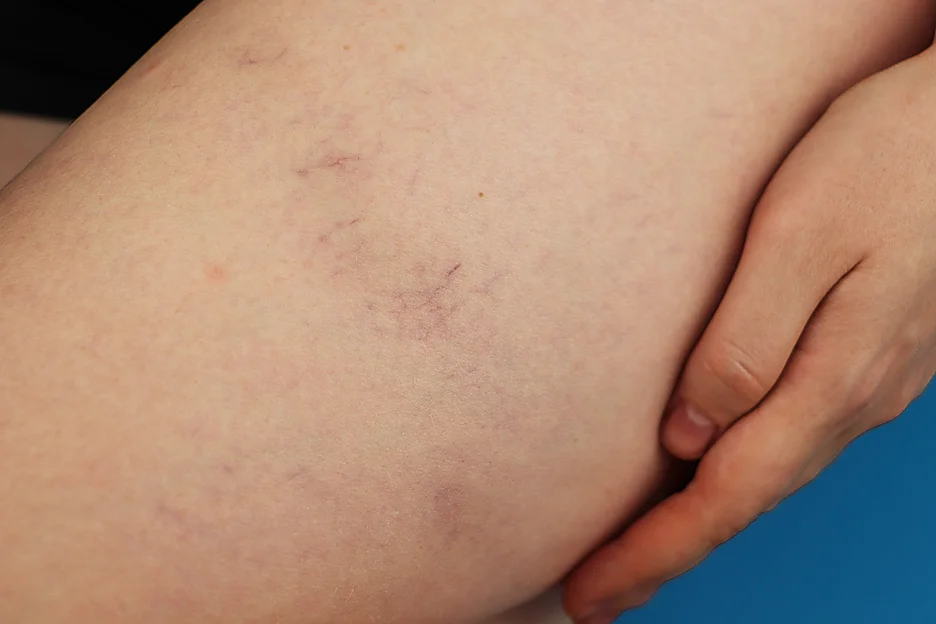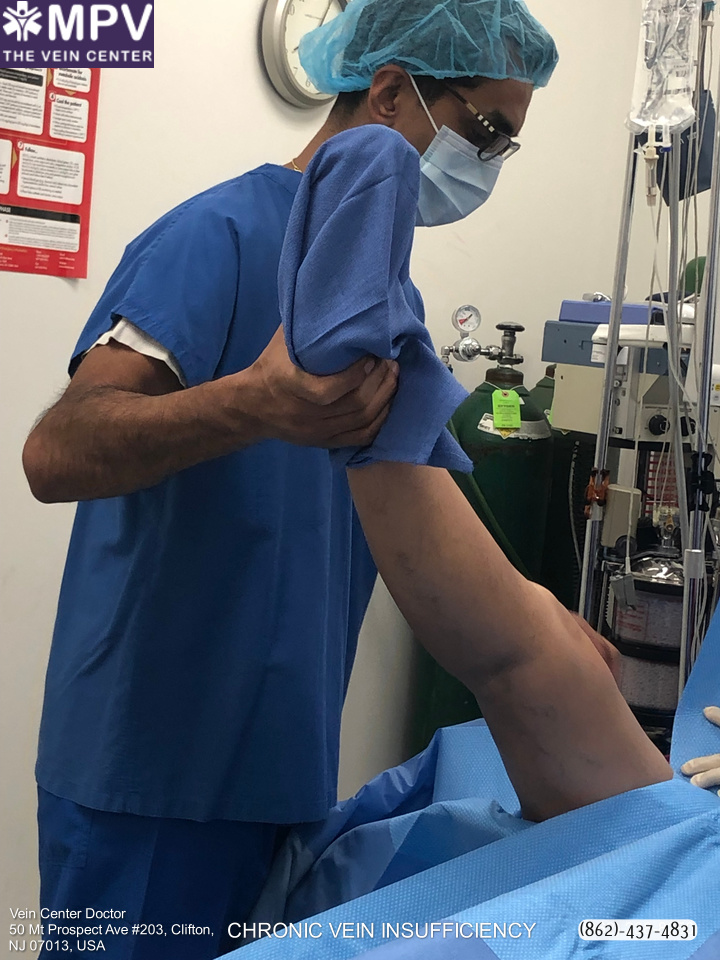Varicose veins are twisted and swollen blood vessels protruding under the skin that can feel painful and itchy. The appearance of varicose veins in the lower limbs is the primary symptom of the second earliest stage of chronic venous insufficiency, chronic venous disease, or venous reflux disorder. Varicose veins affect approximately 25% to 40% of all adults, while the more severe conditions with symptoms such as venous leg ulcers have a prevalence of 17% to 20%.
So what are the best treatments for stage II chronic venous insufficiency or varicose veins? Conservative management of early chronic venous insufficiency symptoms involves treatments aiming to avoid intrusion and preserve organ function. These include compression therapy and manual lymphatic drainage. For prevention, you can undergo sclerotherapy, vein ablation, and VenaSeal as well.
Living with unwanted veins is a thing of the past, when you can simply schedule a free consultation with Vein Center Doctor and find your ideal solution today.
Chronic venous insufficiency is characterized by venous reflux and venous hypertension due to valve incompetence in the lower extremity. Simply put, when valves fail to prevent backward blood flow, venous pressure increases, and vein walls weaken in the lower extremities, enlarging these veins and causing the protrusion of varicose veins.
Additionally, chronic vein disease can be caused by deep venous thrombosis (DVT) which is characterized by excessive blood clots and venous obstruction within the deep veins in the legs.
Blood in the legs flows from the superficial vein system through the perforating system to the deep veins that carry the blood directly to the heart. Vein dilation in the legs happens when valves fail to maintain a consistent upward blood flow and is an indicator of early-stage chronic venous insufficiency, the most characteristic of which is the protrusion of varicose veins.
They usually occur in the veins of the lower extremity or the leg veins (e.g., saphenous vein, iliac vein, femoral vein). Leg vein dilation you may witness in stage II chronic venous disease can take the form of the following:
During stage II chronic venous insufficiency, aside from leg vein dilation and appearance or protrusion of veins, some would feel little to no discomfort, but others may report the following symptoms can also be felt in the legs and may worsen over time:

Several minimally invasive remedies are proven effective against varicose veins or stage II chronic venous insufficiency by improving vein blood flow through or removing the affected veins.
Conservative management involves non-invasive procedures aiming to preserve organ function and prevent disease progression to avoid further complications. In instances when symptoms persist or return even with conservative management, our healthcare providers recommend minimally-invasive outpatient services guaranteed to eliminate stage II chronic vein disease symptoms.
For early-stage chronic venous insufficiency, conservative management therapy is used against mild stage II CVI primarily for improving blood flow, declogging affected veins, and regulating blood clot through procedures that don’t require the puncturing of the patient’s skin or the removal of affected veins. Conservative management therapy includes wound and skin care, exercise therapy, pharmacologic therapy, and manual lymphatic drainage.
Chronic venous disease stage II is caused primarily by venous reflux and backward blood flow in lower extremity veins, whose major risk factors include prolonged standing, sitting, and lack of physical activity. Calf muscle movement can serve as pumps aiding blood flow from the legs and feet to the heart. Similarly, according to a 2004 study, exercise targeting calf muscle conditioning has significantly increased leg vein pumping function.
While there is no guarantee of the disappearance of symptoms in varicose vein patients, especially in more severe cases of varicose veins, exercise therapy is significantly helpful in easing discomfort and preventing more serious symptoms of chronic vein disease.
Venoactive drugs are medications commonly prescribed to chronic venous insufficiency patients in conjunction with compression therapy, strengthening venous tones, reducing excessive blood clot, and improving the permeability of capillaries. These include flavonoids, coumarins, and saponosides.
Anticoagulants or blood thinners are also prescribed to treat chronic vein disease, especially in cases caused by deep vein thrombosis and blood clotting. This decreases the viscosity of blood, aiding blood flow in the deep veins to the heart and reducing gravity-induced backflow of blood in leg veins.
Manual lymphatic drainage is a skin-stretching massage used primarily to treat lymphedema or the accumulation of lymph fluid within tissue due to clogging of capillaries. It works by decongesting lymph vessels and promoting optimal lymph flow to help the body absorb lymph fluid more efficiently and ultimately reduce lymphedema symptoms.
Manual lymphatic drainage is a well-established conservative treatment in preventing edema, a symptom in the later stages of chronic venous insufficiency such as the occurrence of a venous ulcer. Aside from this primary effect, this method is also proven by numerous studies to be effective in improving blood flow and alleviating varicose vein symptoms.
Vein Center Doctor offers comprehensive and state-of-the-art services in treating varicose veins, chronic venous insufficiency, and other vein diseases regardless of severity, preventing complications and avoiding the need for invasive vascular surgery. We provide trusted services on well-established treatment methods such as compression therapy and minimally-invasive intervention procedures such as sclerotherapy, vein ablation, and VenaSeal treatment.
Compression is an old physical therapy method used since ancient times. Evidence of the use of compression therapy dates back to 450-350 B.C. by the ancient Greeks when they used this treatment to counter the negative health effects of gravity and posture.
Compression therapy is the standard treatment for improving blood flow and vein circulation and is a widely-used therapy for chronic venous insufficiency. Compression aims to improve blood flow, revitalize venous valves, increase blood flow velocity, and improve the efficiency of the muscle pump of leg veins, which is a primary force driving blood flow from the lower extremities to the heart. This treatment also helps relieve higher-order symptoms of chronic venous insufficiency such as venous ulceration, leg swelling, skin pigmentation, and edema.
Compression treatment involves the use of compression stockings which aid in keeping the optimal hydrostatic pressure in your leg veins, promoting blood flow and healthy blood circulation and reducing the symptoms of varicose veins. We provide patients with compression stockings suited for every kind of chronic venous insufficiency symptom. Some of the most commonly-used compression stockings are as follows:
Sclerotherapy involves the use of sclerosing agents such as sodium chloride hypertonic solution (23.4%), sodium iodide, and sodium tetradecyl sulfate. These substances are administered through a fine needle into the affected vein, ultimately dehydrating and destroying it. The damaged vein will then be reabsorbed by the body, and blood flow will be redirected to healthy blood vessels.
Sclerotherapy has been a well-established treatment for vein diseases since the 1930s. Modern technology employs two types of sclerotherapy: liquid sclerotherapy and ultrasound-guided therapy. Patients treated with sclerotherapy may only experience mild side effects such as swelling, hyperpigmentation, and inflammation, which go away after a couple of days.
Vein ablation utilizes thermal energy to collapse the damaged vein and redirect blood flow in the legs to healthy veins. In the case of laser ablation, a catheter is used to insert a laser fiber through the damaged veins, destroying its tissue and redirecting blood in the legs to a healthy vein. Before the procedure, patients are administered local anesthesia to help them become comfortable with the pain sensation.
Radiofrequency ablation, like laser ablation, uses thermal energy to treat varicose veins. This procedure is characterized by the use of radiofrequency catheters heated at the tip to burn away affected blood vessels, leaving scar tissue to be absorbed by the body. Radiofrequency ablation is most effective when done in conjunction with the use of compression stockings to avoid side effects; after which the patient can return to their normal routine.
VenaSeal is an innovative treatment procedure utilizing ultrasound imaging of the affected vein prior to the perforation procedure. Through ultrasound examination, the insertion site will be located at the vein’s distal point, where a saline solution will be injected first to flush out blood clots and other venous obstructions.
The VenaSeal adhesive will then be delivered, 3 cm of which will be injected every 3 seconds until the affected vein is entirely covered. This procedure is minimally invasive and with little to no downtime. After the treatment, compression stockings will be applied around the affected area to induce speedy recovery.
Most of the time, the symptoms of chronic venous insufficiency slowly progress through stages, making its diagnosis less convenient for affected patients. To give you an idea about the signs of symptoms for each of its stages and help prevent further progression, below is the categorization of these stages as published in the CEAP (clinical, etiological, anatomical, pathophysiological) consensus.

Some vein diseases like chronic venous insufficiency can be hard to notice at first and can lead to life-threatening complications when untreated. Here at Vein Center Doctor, we ensure that our patients get the fast-acting and efficacious treatment that they deserve.
Vein Center Doctor is a team of licensed vein experts with patient-centered service in mind. To get the best treatment for your vein ailments, contact us at 862-227-1143 (NJ) or 862-227-1054 (NY) for your free consultation.
Find exactly what you need to get rid of your vein-related problems. Dr. Sood and the rest of our team at Vein Center Doctor are ready to help: schedule your free consultation today.
Most Insurance is accepted for treatment